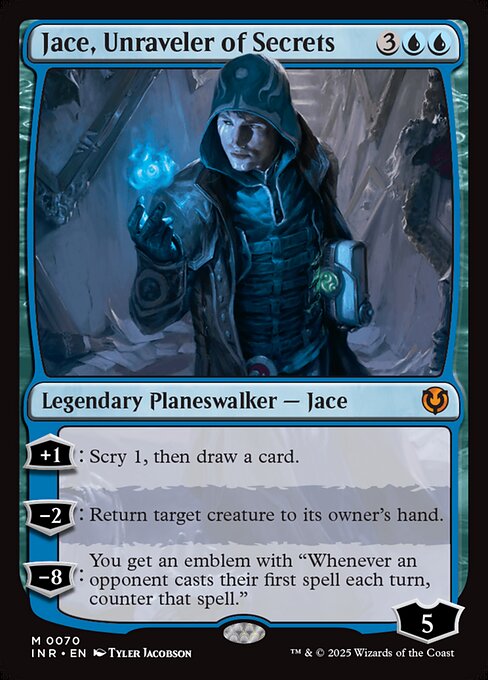
Image courtesy of Scryfall.com
Rarity, Mindset, and the Odd Psychology of Collecting
Rarity in Magic: The Gathering isn’t just about numbers on a card; it’s a living, breathing mirror of how we value ourselves and our collections. 🧠✨ When a card lands in a deck or a binder with the weight of a mythic rarity, it sends a little jolt through our decision-making: scarcity signals importance, scarcity signals prestige, and scarcity nudges us toward ownership—even when the card’s actual play might be modest. The very idea of a “mythic”—a tier above the common, the rare, the uncommon—turns the act of acquiring into a narrative arc: you’re not just playing a game; you’re curating a chronicle. This is the psychology of rarity in real time, and it colors how players approach the collection as much as how they approach the battlefield. 🧙♂️
In the landscape of Innistrad Remastered, Jace, Unraveler of Secrets sits squarely in the blue wheelhouse of control and tempo. With a mana cost of {3}{U}{U} and a formidable five-card total converted mana cost, this legendary planeswalker isn’t the bruiser of the set, but the quiet maestro conducting a sequence of decisions. The +1: Scry 1, then draw a card, is a gentle nudge toward information advantage—an appealing promise in any format where knowing what’s coming matters as much as what you draw. The -2: Return target creature to its owner’s hand offers a versatile disruptor that can blunt the tempo of your opponent’s board, while the -8 emblem—countering the first spell your opponent casts each turn—offers a glimpse of control-crafter fantasy that collectors adore: a payoff that scales with the game’s tempo and weaves into a broader strategic tapestry. ⚔️
Framing this card as a collector’s piece goes beyond the numerical rarity. The card’s reprint in Innistrad Remastered, a Masters-set tribute that often appeals to nostalgia-driven players, reinforces the idea that scarcity and reemergence matter. Foil versions, which often fetch higher prices due to surface shine and rarity, become a tactile signal of achievement; non-foil versions expand accessibility while still carrying the aura of a sought-after planeswalker. Even the card’s price tag—still accessible to many—gives a sense of “entry into the mythic club” without turning ownership into an impossible dream. The psychology here is simple: rarity is a narrative hook, and the card’s design reinforces that hook with a set of utilities that feel both iconic and subtly elegant. 💎
Playful yet precise: how Jace informs scarcity mindset in decks
Jace’s abilities aren’t just about raw power; they’re about the satisfaction of execution. Scrying 1 and drawing a card is a reward loop that scratches the itch of knowledge—every peek into the top of your deck is a small dopamine hit. The -2 bounce shuts down a single threat, granting relief and strategic breathing room. And the emblem on the ultimate is a dream-like payoff: a recurring counter to an opponent’s first spell each turn. It’s not just a victory mechanic; it’s a narrative flourish that makes the card feel rarer than its numbers alone would suggest. This is the essence of rarity perception in action: the card’s identity confirms its status in memory, in collection, and in the imagined awe of “what if” moments in multiplayer games. 🧙♂️🎨
From a collector’s lens, Innistrad Remastered sits at a crossroad: you can savor the art, the lore, and the moment of drawing into a well-timed reveal, or you can chase the more expensive foil iterations that catch light the way a well-cut gem does. The decision becomes a microcosm of the larger collector mindset—value is not solely about playability but about the story you tell with your cards, the moments you chase, and the pride you feel when you hold a card that feels iconic in both design and memory. In this interplay, rarity perception becomes a lens for evaluating not just what you own, but why you own it. 🧠🧙♂️
For modern players and kitchen-table commanders alike, the card’s blue mana identity matters because it aligns with the broader archetypes that reward careful planning and tempo control. The combination of Scry, card draw, and a built-in removal tool—coupled with a late-game emblem—creates a synergy that feels intentionally crafted for players who enjoy the dance of predictability and disruption. The mythic label isn’t just a badge; it’s a signal to the mind that this is a card worth considering in the long arc of a collection and a game plan. 🔮
On the design front, the art by Tyler Jacobson captures the contemplative aura of the character and the world around him. The set’s medieval-modern vibe—glowing runes, weathered stone, and the sense that fate itself might bend to a blue-tinged strategy—helps justify the emotional weight collectors place on the card. That emotional resonance often translates into a willingness to invest in a version that feels extra special, whether through foil treatment, border variations, or simply the pride of owning one of the more recognizable planeswalkers from a beloved storyline. 🎨
And if you’re a connoisseur who also likes to carry your everyday tech with a touch of MTG flair, consider pairing your passion with a stylish accessory. The Neon Phone Case with Card Holder MagSafe Compatible Glossy Matte makes a bold companion piece for any MTG enthusiast on the go, giving you a safe place for your phone and a little space for a card—because even the rituals of daily life benefit from a little magic. It’s a practical nod to how rarity, utility, and personal style intersect in modern collecting culture. 🔥
Neon Phone Case with Card Holder MagSafe Compatible Glossy MatteMore from our network
- https://blog.digital-vault.xyz/blog/post/visualizing-old-growth-dryads-relationships-in-mtg-network-graphs/
- https://blog.digital-vault.xyz/blog/post/distant-hot-blue-star-31179-k-5-solar-radii-2325-parsecs-away/
- https://blog.zero-static.xyz/blog/post/lumra-bellow-of-the-woods-collector-vs-regular-edition-value/
- https://crypto-acolytes.xyz/blog/post/how-to-create-minecraft-realistic-maps/
- https://crypto-acolytes.xyz/blog/post/parallax-uncertainty-clouds-distance-to-a-26-kpc-hot-star/